|
Your new movie Ghosts
of the Odeon - in a few words, what is it about?
Ghosts
of the Odeon is a young boyís
adventure around a long forgotten cinema. Exploring it from the lobby to
the auditorium, he encounters echoes of the past, as iconic movies come to
life. How
did the project come into being to begin with?
Back
in Autumn of 2013 I noticed signs for Chester Film Co-op above two
shop units behind the old Chester Odeon. The building had been closed
since 2007, so any activity was a big thing. I
made some enquiries and found out that the Co-op had been set up by RE:NEW, as part of an artistic programme. It was all connected to the
redevelopment of Chester Odeon into a new cultural centre. I
suggested to my business partner, Mark Ellingham, that we should go along
and see what it was all about. After a few meetings it became clear that
the main focus so far was on contemporary art films - something we have no
great interest in. However
we could see the potential for the Co-op to promote networking between
local film-makers and perhaps even to make some films in Chester. After
a few meetings we were told that RE:NEW wanted the Co-op to produce
several films about the Odeon and its history. Since Mark and I were the
only film-makers in the Co-op we took on the commission. We abandoned the
brief of filming a few shots inside the old cinema building and decided to
make a short film - Ghosts
of the Odeon.
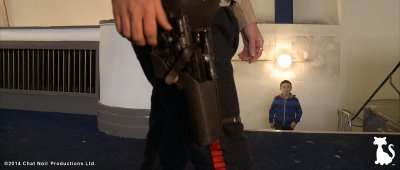 |
What were
your inspirations when dreaming up Ghosts
of the Odeon, and what kind of fun was it to include all those
hommages to classic movies?
I
think it all started when I was outside the Odeon one night in the rain.
The cinema, although now in a state of disrepair, is a beautiful Art Deco
building - one of only two of its kind ever made (the other being in
York). After
all these years it is a bit of a sad sight and for some reason Rutger
Hauerís ďTears in rainĒ speech came into my head. Maybe it was the
rain and the street lights, maybe I just love Blade Runnerís
aesthetic too much - but the idea just seemed perfect.
Iíd
been on a tour of the building and the shapes and forms in there presented
many exciting visual opportunities. From
day one I had the image of the cinema in the rain with the Blade Runner
voice-over ďIíve seen things you people wouldnít believeĒ - then
BOOM to the opening eye and then tracking shots over the lobby - almost
mimicking the shots panning over the surface of the Nostromo in Alien.
I
also had the finale, with a little boy - looking over the ruined grandeur
of the auditorium with the ďall these momentsĒ section of the speech
floating through the ether. Thatís
all I had, but I knew whatever we put between those two scenes, we had a
film that could bring a tear to the eye.
The
challenge was how to make a ďhomageĒ film without it becoming cheesy.
Itís very hard to replicate other movies without it looking like
over-eager cosplay. Itís about getting the tone of those movies and
treating them with a lightness of touch. Never being too geeky or too
referential. The idea was to make the film work even if people didnít
get every nod. The drama and the excitement had to be separate from the
references, but reinforced by them - if you Ďgotí the quotes. Beyond
that, it then simply came down to what was physically possible, taking
into account the time available and the use of visual effects. We made
lists of the films we would like to include and then scribbled notes as to
how we could achieve them.
How would you describe your
directorial approach to your subject at hand?
The
focus of the film always had to be on the boy having the adventure and the
film hardly ever cuts away from him. There was a certain amount of
mimicking other filming styles, but mainly it was about being reactive to
the environment and the action. I
shot the film in 2.35 which gives the film the real ďwidescreenĒ look,
but comes with its own set of problems, mainly involving how you compose
shots and the type of cutaways you use. My
main philosophy was to let things play out in that widescreen and keep the
shots a little wider and richer in their composition. We used a small
amount of hand held, quite a few tracking shots in the opening and the
finale. While
I wanted to show the building off, I didnít want slavishly to fill the
film with wide shots of the architecture. It was far more interesting to
try and use it to give echoes back to the films we were homaging. The best
example of this is the scene with the Facehugger, where the chair backs
start to look like the boney structure inside the derelict.
You just
have to talk about your location, Chester's Odeon, for a bit, and
what was it like shooting there?
The
Chester Odeon is an Art Deco cinema that was opened in 1936 by Douglas
Fairbanks Jr. Itís
a stunning building, but in its present state you can only see half the
grandeur and luxury it must have represented when it first opened. Itís
been redesigned and modified over the years, splitting the one large
screen into five smaller screens. But even that doesnít diminish the
thrill and the impact of standing at the back of the cinema, looking down
at the large screen. Being
a concrete structure, it is surprisingly cold inside, even on the hottest
days of the year, so we had to make sure that everyone had coats and
jumpers. Having
visited the cinema when it was open, I knew the basic layout very well,
but again it was strange taking cameras into a building that had been such
a big part of my childhood.
Do talk about your cast
for a bit, and why exactly these people?
|
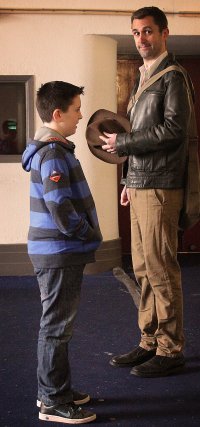
Jack Clayton, Nathan Head |
We
always knew the hardest part to cast in the film, would be that of the
young boy, as so much of the filmís success would rest on him. In any
fantasy situation the reality comes from how the characters react to it. Iíd
worked with Jack in 2009 on a corporate film, where he had a small role.
Even that part involved special effects and imagination on his part, so I
was confident he would be able to pull off the role. We
put the film together very quickly and unlike shooting a feature film
there was no time to prep or plan a lot of the filming in advance.
Jackís mum is also an actress. I had told her the basics, but I didnít
get to speak to Jack himself until we were on set. We filmed very quickly
to get through all the scenes and I canít praise Jack enough for how he
coped with what must have often seemed like very surreal direction from
me.
Nathan Head [Nathan Head
interview - click here], who plays all the other roles in the film (Marty McFly, Han Solo and
Indiana Jones) is an actor Iíve known for some time but never worked
with before. I suggested Nathan join the Co-op and, as we were putting the
film together, he seemed the obvious choice to play all the remaining
parts. Sadly, his face never appears on screen, but Iím hoping to work
with him again and give him a more featured role.
What can you
tell us about the shoot as such, and the on-set atmosphere?
We
had a very tight schedule to get through. The initial shoot was just 6
hours, including set-up and strike. There hadnít really been time to
script the film or storyboard it, but I had detailed notes for all the
scenes and had the blocking sorted in my head. We
used tracks in the opening scenes, which always slow things down, but did
help to ease us into the rhythm of filming. It
was a little surreal to begin with, staging all these scenes in the
context of the derelict building. But I tend to edit as I go along inside
my head, and very quickly I could see the footage we were getting was
hitting the right tone. The
shoot was manic, running from set-up to set-up, while dealing with costume
changes and props. Jack
only got the giggles once - but to be fair that was during the 2001
scenes, which came very late in the day and required a lot of imagination.
By
the time we had finished the first day we were utterly drained, but
buzzing with the excitement of what we had achieved. That
evening I cut together the footage, which formed probably 80% of the film
you now see. There were a few shots I was eager to re-shoot, either
because of focus or lighting issues. But I could also see the potential to
turn something good into something great. I
scheduled a second filming day of just two hours for pick-ups and then
started work building or acquiring the additional props we would need. It
was at this stage that we added ET, the Facehugger and Gizmo, which now
seem so central to the film. The
second shoot day was just as fun, doing pick ups and adding extra scenes.
It was actually Jackís 11th birthday and so after we wrapped we all had
cake and doughnuts.
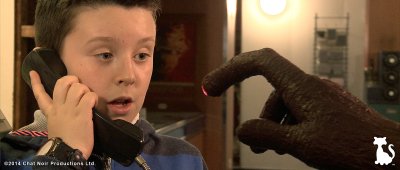 |
The
$64-question of course, where can Ghosts
of the Odeon be seen?
We
were very proud that the Ghosts
of the Odeon actually premiered on
the main screen inside the Chester Odeon, during a heritage open weekend
held by RE:NEW and Cheshire West and Chester Council. It was a real thrill
to see it on such a big screen, the same screen that showed the re-release
of Star Wars: A New Hope in 1997!
The
film can be found easily online:
www.cnpfilms.com,
which is our official website for film and TV projects.
www.chesterfilmco-op.co.uk,
the website for the Chester Film Co-op.
Do talk about audience and
critical reception of your film so far for a bit!
I
always hoped the film would go down well, because it features respectful
homages to films (and an era of film-making) that people love. When
youíre in the middle of making a film, you often donít know how the
film is going to turn out, there are so many variables and one small
element can undermine all the other good work. When we premiered the film
on the Odeonís main screen, the reaction was good. The people had been
on a tour around the building and the last thing on their itinerary was
viewing the film. After
that I shared the film with contacts in the film industry, a lot of whom
have worked on the films featured in Ghosts
of the Odeon. The reaction has been
amazing. I have emails from the most cynical and industry-weary vets, who
admit to having shed a tear or two. For
a film we made quickly, on a ridiculously tight budget, Iím very proud
of the team and the reaction their work is getting.
Any
future projects you'd like to share?
We
have just completed work on A Life at the Pictures, a short
interview film with an old lady who remembers the Odeon opening in 1936.
Also made for RE:NEW, the film is a mix of interview footage and archive
photographs - http://youtu.be/Fauj-ZU9Urg
For
a couple of years now Iíve been developing a project called The
Fractured Man, another original screenplay and quite unlike anything
Iíve done before. Like Ghosts
of the Odeon it is the product of my love of growing up
loving movies, but unlike Ghosts
of the Odeon it is original and not a pastiche
- however loving. Itís hard to share a synopsis without giving away the
plot, but what I can say is that itís an adventure film, dark and
dangerous: Indiana Jones via Inception and Steven Moffatís
Doctor
Who. The
script has gone through A LOT of drafts, but mainly Iíve been waiting
for camera technology to improve / come down in cost. Iíve
shot numerous commercial projects in HD and as great a format as it is, I
want to shoot the film in 4K, as I just donít think HD is good enough to
hold the large widescreen 2:35 shots Iím planning. Dreamscape,
my first feature, was very much Ď60s John Frankenheimer crossed with
Ridley Scott. With Fractured Man, Iím very much heading for Ridley Scott
crossed with Martin Campbell, if not story-wise, at least visually.
What got you into
filmmaking to begin with, and what can you tell us about your education on
the subject?
|
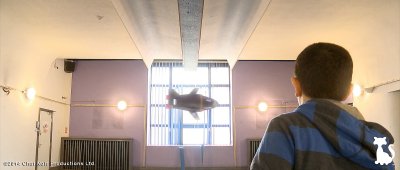
|
From
a very early age, probably 5 or 6, I had a complete and utter fascination
with movies and the creation of moving images. I think the blame for this
can be laid firmly with my father, who introduced me to Gerry Andersonís
Thunderbirds, Stingray
and (my favourite) Captain Scarlet.
What I gained from these TV shows was an appreciation for a world created
entirely from scratch. In the Anderson puppet shows there was no location
film, off-the-shelf props or costumes - everything that appeared on screen
had been designed and made - even the puppet cast. My
love of films quickly extended to Harryhausen, Star Wars, Bond... in fact
a lot of the films that are quoted in Ghosts
of the Odeon. At
high school I did ok, grades-wise, but my real love and interest was in
films. Most break periods involved talking about movies or sharing scripts
with a group of friends, which included my now business-partner, Mark. After
school it was suggested that I should go to uni and pursue film-making. I
honestly wasnít keen on the idea of three more years of education, but
my family and especially my late grandfather said it would be the best
thing for me. I
joined HND Film and Television Design at the NEWI in Wrexham, Wales, and
for two years had pretty much constant hands-on experience making films.
The course was for the most part self-taught, learning by doing, which was
fine for me as it allowed for lots of experimentation. During my second
year, I made Mindfield - a Blake's
7-esque thriller, filled with
lots of action, stunts and special effects. I
was very lucky to be at university with a talented, maverick group. We
lived and breathed movies. As we were heading towards the end of our two
years of the HND, we realised that we were in danger of leaving university
with only a small percentage of the skills we needed and that our best way
to progress as film-makers was to keep working together on film projects. So
we wrote letters and had meetings with the senior management of the
university, campaigning for them to create a degree for us. Eventually
they agreed and set up BA Hons in The Moving Image, a course which,
in a modified form and with a new name, still runs today.
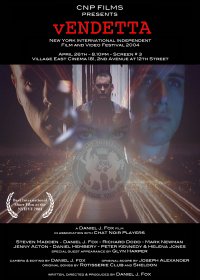 |
You just have to talk about your graduation
movie vENDETTA for a bit, and the impact it went on to make?
When
I started the degree, the first year was focused around several short
projects, which didnít really interest me. I knew the only way I was
going to learn and develop as film-maker was by stretching myself towards
the feature film style. So
I produced the short films quickly in a few afternoons and then started
work on vENDETTA. Over the next year I shot scenes with the help of
my fellow university students. By the end of the first year I had a rough
cut of the film, which was a mix of good and bad. I was able to look at
the weaker scenes - some were cut, others re-shot.
http://youtu.be/50jpoBbEDY0
http://youtu.be/rNmKHJEDM1Y
It
was a great exercise to take the film apart and really look at what worked
and what didnít. By
the time I submitted the film to my tutors it was 45 minutes long. They
must have liked it, as the marks went towards me getting a BA (Hons) First
Class. Before
I left uni for good, I added extra scenes bringing the film up to 56
minutes in length. If Iíd had the time I would have extended it further
to feature length, but at the time, this was a massive achievement. The
year after (2004) we took the film to the New York International
Independent Film and Video Festival, winning the award for Best
International Short.
Also,
do talk about your feature debut Dreamscape, and how did it come
into being?
|
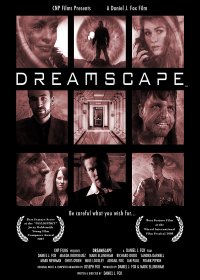
|
In
this business youíre only as good as your last film. I knew that while vENDETTA
was a nice landmark on the road, it didnít really reflect on what I could
do in film. The
initial idea was to make a short film, to try out some new techniques and
to produce a film that built on what we had learnt making vENDETTA.
So we started with good intentions - a simple no special effects, black
and white thriller film-noir with a hint of sci-fi, more John
Frankenheimer than Ridely Scott. We
again used some of the cast from vENDETTA as well as bringing in a
new core of actors, including Sandra Darnell and Magda Rodriguez from
London to play the filmís two female leads. Somewhere
along the line the film started to grow and develop. Running concurrently
with Dreamscape, Chat
Noir was starting to dabble with CGI for a
documentary project. When I started to see the results we could achieve,
it set me thinking. It
wasnít long before we had a CG city being built, helicopters, a monorail
- all of which helped to open up what had been a very interior story. Shooting
in black and white helped us make the CG integrate into the live-action
and while keeping the film-noir feel that had been the original
inspiration. We
ended up with a film 56 minutes long, which was too long to be a short and
too short to be a feature film. What we had really worked, but there was
space to add extra scenes and to add effectively a third act... which is
what we ended up doing. The
whole making of Dreamscape was mammoth, but also the best learning
experience possible, as not only did we make a feature film, but we were
able to take it apart hal way through production and really look at story
structure and plotting. The
film has sat on various distributorsí desks over the years, I think the
black and white being a problem for most to find a market for. In the last
six months Iíve decided to bite the bullet and put it out there on VOD.
I think there is an audience for a film like Dreamscape, and if
nothing else it will be the first calling card to other things.
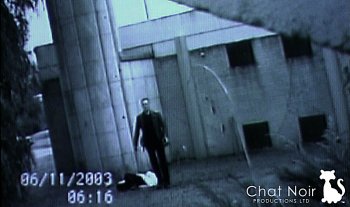
vENDETTA |
Any other films of yours you'd like to
share?
Weíve
made a lot of films over the years for a variety of clients. Two stick out
in my mind: One
is actually a series of documentary films that we have filmed and produced
for my brother and sistersí company, Lost in Castles -
http://www.lostincastles.com. This is an on-going series of DVDs recreating
medieval castles around the UK, using on-location filming and CGI
modelling. So far we have filmed Middleham, Sandal, Conwy and most
recently Rhuddlan Castle.
http://youtu.be/NUu_AePh_c8
http://youtu.be/7wN-3xF0Tjo
http://youtu.be/q60Tx-RZ-nM
The
other project is a film about childhood sexual abuse for a local charity, The
Lantern Project - http://www.lanternproject.org.uk. We started work on this film long before child
abuse was such a common headline in the British press and it was exciting
to work on a film that could actually help and change lives.
http://youtu.be/Dnh3bR9dQc8
The
opening scene, a very disturbing scene shot in another stunning broken
down location, is a perfect example of what makes Chat
Noir Productions unique. It plays like a scene from a movie, with lush production values,
acting, music and sound work - drawing the audience into the film,
connecting with them on an emotional level.
A few word about your company Chat
Noir Productions, and the philosophy behind it?
|
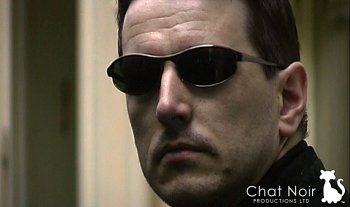
vENDETTA |
Chat
Noir was incorporated by myself and Mark Ellingham, who has been a friend
since high school. We have very similar tastes, but also different
strengths and outlooks, so are a great mix when it comes to working on
productions. We
decided we wanted to set up a production company after university for
corporate work. At that time we were also working other jobs, in TV and
live events, but we still built up a pretty respectable portfolio of work.
Around
2009, after we had completed Dreamscape, we decided to re-focus the
company as ďCreative Video SolutionsĒ, bringing to the client market
everything we had put into Dreamscape - a one stop production
company, taking a film from script to screen. We approach any film
production as we would a drama, with high attention to detail and design -
something that is sadly unusual in client-based film projects.
How
would you describe yourself as a director?
Iím
very hands on and I know what I want. Iíve
drawn since I was very young, so pictures and images have always been very
important to me. I donít tend to storyboard heavily, as I usually have
the film in my head, shot by shot. Itís then just a matter of building
the jigsaw of shots, while at the same time looking at light, performance
etc. Over
the years Iíve shot most of what Iíve directed and edited too, so I
can be very efficient when it comes to the type of coverage I need. This
allows me to be very specific and to craft images that tell the story,
rather than rely on general coverage to build a scene afterwards in the
edit. I
like to film fast, with lots of energy, natural light where possible. Once
you get into a rhythm on -set the scenes tend to fly by. Iíve
done most jobs on and off set over the years, so know the complications
and also how my requests will have an impact on other people. So I know
that moving the camera in a certain way will save a rotoscope artist hours
of work. So, Iíll do that, as it will mean that they can do another shot
in the time saved.
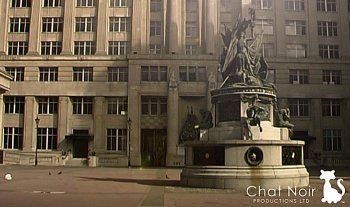
vENDETTA |
Filmmakers
who inspire you? Ridley
Scott, Martin Campbell, Steven Spielberg, Christopher Nolan, John
Frankenhiemer, Sergio Leone, Billy Wilder. Your favourite movies? Goldeneye,
Empire Strikes Back, Alien, Blade
Runner, Casino Royale, Star Wars, The
Manchurian Candidate, Seconds, Sweet Smell of Success, Ace in the
Hole, Gladiator, Die Hard, Lethal Weapon, The
Thing, Inception, The Prestige,
Get Carter, Where Eagles Dare, Raiders of the Lost Ark,
Singing in the Rain, Wrath of Khan, Once Upon a Time in the
West, Once Upon a Time in America. ...
and of course, films you really deplore? Die
Another Day, Star Wars-prequels, Matrix-sequels. But you can learn a lot
from watching them... A well constructed movie is a thing of beauty, but a
badly made film with all the thought processes and ideas rough, ready and
undeveloped is far more informative. Your/your
movie's website, Facebook, whatever else?
www.cnpfilms.com
www.chatnoirproductions.co.uk
https://www.facebook.com/ChatNoirProductions
https://www.facebook.com/chesterfilmcoop
https://twitter.com/Daniel_J_Fox
https://twitter.com/ChatNoirProds
Anything else
you are dying to mention and I have merely forgotten to ask?
 |
Feeling lucky?
Want to
search
any of my partnershops yourself
for more, better results?
(commissions earned) |
The links below
will take you
just there!!!
|
|
 |
Never
forget the music. I see so many movies that are utterly destroyed by
bad scores, too loud scores, scores trying to be ďcoolĒ. I
cannot read music and I cannot compose, but Iím lucky to work with
two composers (who also happen to be my younger siblings) who have
become very good at interpreting my notes on what a scene needs and
turning it into appropriate but also memorable music. Film
scores run this narrow line between not being heard, while at the same
time giving a film so much of its identify and soul. A film is often a
hollow and directionless thing until those last few moments where you
add the score and mix it with the sound effects. Thatís a scary
thing for a director as all their hard work can succeed or fail,
depending on what the composer adds...
In
my defense, I never see my films without music. Even in the very early
edit stages in my head I can factor in what the music will bring. That
simply comes from having made a lot of client films over the years. On
Ghosts
of the Odeon we were able to recreate all the classic
film scores, ones which still fill my CD collection and iTunes. For me
that is the real thrill as itís the part of the process I donít
have hands-on control over, other than saying, Ďno that doesnít
sound rightí or Ďthatís great, donít change a thingí.We
started recreating the music almost note for note, but then as we went
on, we became a little freer and let the drama and the images dictate
where the music was heading. And
I suppose that neatly explains my entire philosophy of film-making - films
are about getting the details right, being very specific and exact,
but also learning when to use broader strokes, which might not be
technically correct, but is dramatically and emotionally correct. And
thatís how you reach an audience.
Thanks
for the interview!
|